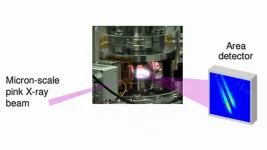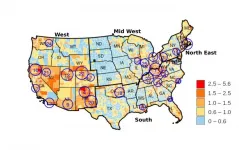Lower rates of kidney transplant referrals at for- vs. non-profit dialysis facilities
Additional research is needed to uncover the reasons for this disparity
2021-05-27
(Press-News.org) Highlights
Among patients receiving dialysis in the Southeastern United States, those at for-profit dialysis facilities were less likely to be referred for kidney transplantation than those at non-profit facilities.
Rates of starting medical evaluations soon after referral and placing patients on a waitlist after evaluations were similar between the groups.
Washington, DC (May 26, 2021) -- New research indicates that patients with kidney failure who receive care at for-profit dialysis facilities are less likely to be referred for kidney transplants that those receiving care at non-profit facilities. The findings will appear in an upcoming issue of CJASN.
Kidney transplantation is the optimal therapy for most patients with kidney failure. Many patients first initiate dialysis and are referred for a transplant by kidney specialists through dialysis facilities. Previous studies have reported that patients treated at for-profit dialysis facilities are less likely than those treated at non-profit facilities to be placed on a transplant waitlist and to receive a transplant. Little information is available concerning earlier steps in the process, however--namely, referrals and medical evaluations for transplantation.
To investigate, a team led by Rachel E. Patzer, PhD and Laura J. McPherson, MPH (Emory University) examined referral and evaluation data from all 9 transplant centers in the Southeastern United States (Georgia, North Carolina, and South Carolina), as well as information from the United States Renal Data System.
The analysis included 33,651 patients with kidney failure who initiated dialysis in the Southeast from 2012 to 2016. Eighty-five percent of patients received dialysis treatments at for-profit facilities, and 15% were treated at non-profit facilities. A total of 44% of patients were referred for transplant during the 4-year study period. After adjustments, patients at for-profit facilities were 16% less likely to receive a referral than patients at non-profit facilities. Rates of starting medical evaluations within 6 months of referral and placing patients on a waitlist within 6 months of evaluations did not meaningfully differ between the groups.
"Our study offers insight into the practice patterns related to referral for transplantation, start of the transplant evaluation at the transplant center, and placement on the national deceased donor waiting list, but our study does not have detailed information about the mechanisms and reasons for these differences in referral between for profit and non-profit facilities," said Dr. Patzer. "The reasons for these differences in referral could be due to differences in patients' health status that are not measured in our dataset, or they could be due to other unmeasured factors such as limited time to educate or refer patients for transplant, or unconscious bias. Future research is still needed to better understand these mechanisms, such as through focus groups and interviews with patients and care provider team members."
An accompanying editorial notes that "the early steps in transplant access remain frustratingly opaque, indicating the ongoing need to address long-standing disparities and ensure equity in treatment options for patients with kidney failure."
INFORMATION:
Study co-authors include Elizabeth R. Walker, MD, Yi-Ting Hana Lee, MPH, Jennifer C. Gander, PhD, Zhensheng Wang, PhD, Amber M. Reeves-Daniel, DO, Teri Browne, PhD, Matthew J. Ellis, MD, Ana P. Rossi, MD, and Stephen O. Pastan, MD.
Disclosures: The authors reported no financial disclosures.
The article, titled "Dialysis Facility Profit Status and Early Steps in Kidney Transplantation in the Southeastern United States," will appear online at http://cjasn.asnjournals.org/ on May 26, 2021, doi: 10.2215/CJN.17691120.
The editorial, titled "Dialysis and transplant access: Kidney capitalism at a crossroads?" will appear online at http://cjasn.asnjournals.org/ on May 26, 2021, doi: 10.2215/CJN.04680421.
The content of this article does not reflect the views or opinions of The American Society of Nephrology (ASN). Responsibility for the information and views expressed therein lies entirely with the author(s). ASN does not offer medical advice. All content in ASN publications is for informational purposes only, and is not intended to cover all possible uses, directions, precautions, drug interactions, or adverse effects. This content should not be used during a medical emergency or for the diagnosis or treatment of any medical condition. Please consult your doctor or other qualified health care provider if you have any questions about a medical condition, or before taking any drug, changing your diet or commencing or discontinuing any course of treatment. Do not ignore or delay obtaining professional medical advice because of information accessed through ASN. Call 911 or your doctor for all medical emergencies.
Since 1966, ASN has been leading the fight to prevent, treat, and cure kidney diseases throughout the world by educating health professionals and scientists, advancing research and innovation, communicating new knowledge, and advocating for the highest quality care for patients. ASN has more than 21,000 members representing 131 countries. For more information, visit http://www.asn-online.org.
ELSE PRESS RELEASES FROM THIS DATE:
2021-05-27
Scientists at the Centro Nacional de Investigaciones Cardiovasculares (CNIC) have identified the first blood biomarker for myocarditis, a cardiac disease that is often misdiagnosed as myocardial infarction. Nevertheless, the diagnosis of myocarditis continues to be challenging in clinical practice.
The study, led by Dr. Pilar Martín and published today in The New England Journal of Medicine, has detected the presence of the human homolog of micro RNA miR-721 in the blood of myocarditis patients.
CNIC General Director Dr. Valentín Fuster emphasizes that these results of paramount importance because they establish the first validated blood marker with high sensitivity and specifity (>90%) for myocarditis. This will allow ...
2021-05-27
Continuous skin-to-skin contact starting immediately after delivery even before the baby has been stabilised can reduce mortality by 25 per cent in infants with a very low birth weight. This according to a study in low- and middle-income countries coordinated by the WHO on the initiative of researchers at Karolinska Institutet published in The New England Journal of Medicine.
Continuous skin-to-skin contact between infant and mother, or "Kangaroo Mother Care" (KMC), is one of the most effective ways to prevent infant mortality globally. The current recommendation from the World Health Organization (WHO) is that skin-to-skin contact should commence ...
2021-05-26
ITHACA, N.Y. - Soil carbon storage, carbon capture and storage, biochar - mention these terms to most people, and a blank stare might be the response.
But frame these climate change mitigation strategies as being clean and green approaches to reversing the dangerous warming of our planet, and people might be more inclined to at least listen - and even to back these efforts.
A cross-disciplinary collaboration led by Jonathon Schuldt, associate professor of communication at Cornell University, found that a majority of the U.S. public is supportive of soil carbon storage as a climate change mitigation strategy, particularly when that and similar approaches are seen as "natural" strategies.
"To me, that psychology part - that's really interesting," Schuldt ...
2021-05-26
With brilliant colors and picturesque shapes, many crystals are wonders of nature. Some crystals are also wonders of science, with transformative applications in electronics and optics. Understanding how best to grow such crystals is key to further advances.
Scientists from the U.S. Department of Energy's (DOE) Argonne National Laboratory, along with three universities, have revealed new insights into the mechanism behind how gallium nitride crystals grow at the atomic scale.
Gallium nitride crystals are already in wide use in light-emitting diodes, better known as LEDs. They might also be applied to form transistors for high-power switching electronics to make electric grids more energy efficient and smarter. The use of such "smart grids," which ...
2021-05-26
The opioid epidemic is taking a deadly toll on people in disproportionate clusters from Cape Cod to San Diego, according to a new study by the University of Cincinnati.
Fatal opiate overdoses are most prevalent among six states: Ohio, Pennsylvania, Kentucky, West Virginia, Indiana and Tennessee. But researchers identified 25 hot spots of fatal opioid overdoses nationwide using data from the Centers for Disease Control and Prevention.
The study demonstrates how both widespread and localized the problem of substance use disorders can be, UC assistant professor and co-author Diego Cuadros ...
2021-05-26
What is happening deep beneath the surface of ice planets? Is there liquid water, and if so, how does it interact with the planetary rocky "seafloor"? New experiments show that on water-ice planets between the size of our Earth and up to six times this size, water selectively leaches magnesium from typical rock minerals. The conditions with pressures of hundred thousand atmospheres and temperatures above one thousand degrees Celsius were recreated in a lab and mimicked planets similar, but smaller than Neptune and Uranus.
The mechanisms of water-rock interaction at the Earth's surface are well known, and the picture of ...
2021-05-26
Modern-day agriculture faces two major dilemmas: how to produce enough food to feed the growing human population and how to minimize environmental damage associated with intensive agriculture. Keeping more nitrogen in soil as ammonium may be one key way to address both challenges, according to a new paper in the Proceedings of the National Academy of Sciences (PNAS).
Today's use of nitrogen fertilizers contributes heavily to greenhouse gas emissions, air pollution, and water pollution, but they are also essential for growing crops. Reducing this pollution is critical, but nitrogen use is likely to grow with increased food production. At ...
2021-05-26
UNIVERSITY PARK, Pa. -- One of the most important and widespread reef-building corals, known as cauliflower coral, exhibits strong partnerships with certain species of symbiotic algae, and these relationships have persisted through periods of intense climate fluctuations over the last 1.5 million years, according to a new study led by researchers at Penn State. The findings suggest that these corals and their symbiotic algae may have the capacity to adjust to modern-day increases in ocean warming, at least over the coming decades.
Cauliflower corals -- which are in the genus Pocillopora -- are branching corals that provide critical habitat for one-quarter of the world's fish and many kinds of invertebrates, such as lobsters, sea urchins and giant clams. ...
2021-05-26
To help patients manage their mental wellness between appointments, researchers at Texas A&M University have developed a smart device-based electronic platform that can continuously monitor the state of hyperarousal, one of the signs of psychiatric distress. They said this advanced technology could read facial cues, analyze voice patterns and integrate readings from built-in vital signs sensors on smartwatches to determine if a patient is under stress.
Furthermore, the researchers noted that the technology could provide feedback and alert care teams if there is an abrupt deterioration in the patient's mental health.
"Mental health can change very rapidly, and a lot of these changes remain hidden from providers or counselors," said Dr. Farzan Sasangohar, assistant ...
2021-05-26
Like a good story, feeding has a beginning, a middle and an end. It begins with appetite prompting the search for food, continues with eating the food and it ends when satiation hits and the consumption of food is stopped.
At Baylor College of Medicine, Dr. Qi Wu, Dr. Yong Han and their colleagues have uncovered new aspects of the last part of this story that relate to the little-known neural circuits and neurotransmitters involved in ending food consumption.
The team discovered a novel circuit that connects a unique subset of dopamine-producing neurons with downstream neurons in the hindbrain (lower brainstem) ...
LAST 30 PRESS RELEASES:
[Press-News.org] Lower rates of kidney transplant referrals at for- vs. non-profit dialysis facilities
Additional research is needed to uncover the reasons for this disparity




